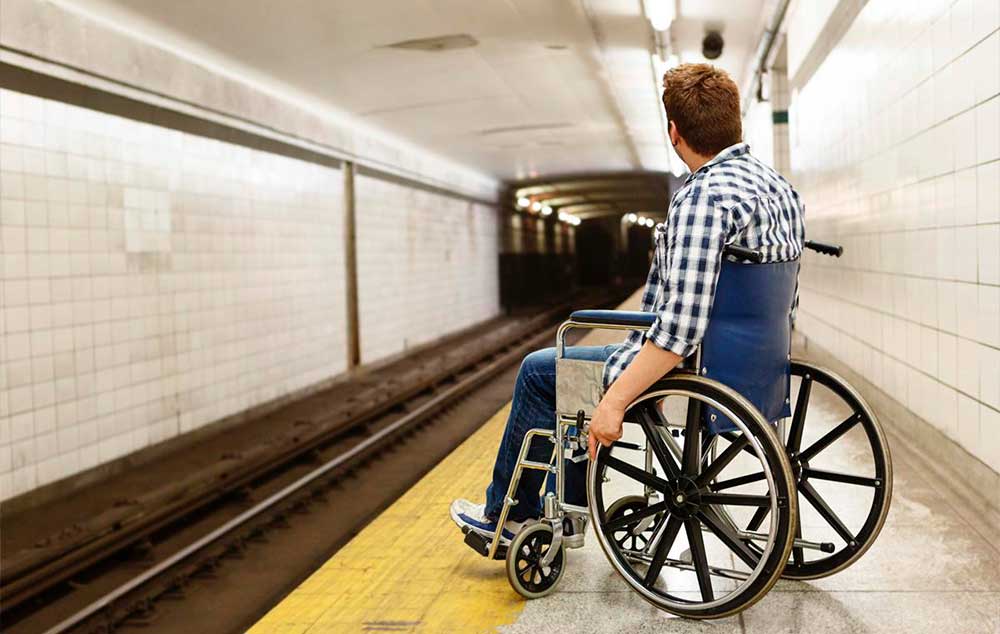It’s 8:20 a.m. and you’re late. Clients will be in your office by 9:30 a.m., and your boss is counting on you to land this account.
With the kids off to school you scurry a block to the subway, hustle down the stairs and do your best to make yourself skinny by turning sideways, pushing to the front of the platform and getting on the train.
You’re off. What a relief!
Everyone can relate to the scenario described above. Who hasn’t been late for an appointment or client meeting? The anxiety you feel is real.
However, for the millions of Americans like me who overcome physical disabilities every day, the anxiety most people associate with running late is an emotion I always feel. I just don’t know what’s waiting for me when I’m on a business trip to New York.
At home, in Phoenix, Ariz., where urban sprawl and freeways are the order of the day, I just hop in my car, equipped with hand-controls, and I’m off to whatever needs to be done.
But like the 900,000 people with disabilities who call New York City home, when I’m in Manhattan — which I love for its energy and culture — all bets are off.
Getting a cab from my hotel is never a problem because the hotel personnel are typically quite helpful.
Getting a cab back to my hotel when my work is done? Forget about it! Simply put, cabs don’t seem eager to stop.
Taxi drivers usually don’t see a businessman in a titanium rigid-frame wheelchair that probably costs more than the refurbished Crown Victoria police cruiser they’re driving; they see more time and effort for the same fare.
Uber is redefining the transportation landscape. Traditional cab companies and transit unions don’t care for Uber because the San Francisco-based company is something they’ll never be — agile.
For the most part, I’ve had decent luck with Uber, but I find my “luck” is directly proportional to the service I use. UberX is hit-or-miss. Uber Black, on the other hand, has been, at least to date, outstanding.
So the correlation is: Spend more money, get better service. But why is this necessary?
I believe it goes back to what I said before: Cabbies, Uber drivers and MTA officials often don’t see the person in the wheelchair. They only see the chair itself as a problem to be accounted for; an appendix at the end of an already well thought out transportation plan.
Unlike the sons, daughters, husbands, wives, parents and grandparents who use them to live life to the fullest, wheelchairs are not endowed with spirit. But the people who use them are, and we deserve better.
Like anyone of consequence, people with mobility challenges have places to go, people to see, kids to raise and business deals to close. It’s too bad the transportation challenges in New York make it so difficult.
The city has 490 subway stops, but less than 100 are wheelchair accessible. There are 581 accessible yellow cabs and 1,800 accessible green taxis for nearly one million people with a physical disability who live in the city.
How many of them are in service at any given time? If I were a betting man I’d say not many.
UberWAV and UberASSIST are great in theory but have a long way to go if they’re ever going to do anything more than placate the Department of Justice.
My goal isn’t to bash companies or government entities for not doing enough. But as a society we must remember that today is only meaningful if we carry the lessons we learn forward. If we don’t, how can we expect tomorrow to be better?
Human nature is such that people are less inclined to identify with circumstances that don’t affect them. For example, when I meet people who tell me they’ve never thought about what it must be like hailing a cab in a chair or traveling on wheels, you know what I tell them? “Good. I’m glad.”
And then I say, “But now that we’re friends you have an obligation to examine life from a perspective other than your own.”
I don’t say this I because I want pity or admiration. I say it because examining life from a different perspective is a good first step toward addressing any challenge.
There are 54 million American adults living with some type of physical disability. According to the Pew Research Center, there are more than 74.9 million Baby Boomers in this country. Further research indicates that 50% of Boomers over age 65 already have lived with some type of mobility impairment.
The transportation challenges that people with disabilities face in New York aren’t unique to this city. Transportation is a major issue for people with disabilities across this country. We can do better. We must do better.
Some are unmoved by the millions of people with disabilities protesting for better transportation options. I’m not here to tell you how to feel or what to do.
But let me leave you with two indisputable facts: One, no one knows what the future holds; and two, you’ll never be as young as you are today.
Wouldn’t it be awesome if we tackled these transportation challenges today so you don’t have to deal with the same headaches many of us do when you need accessible transportation?
Source: Daily News



